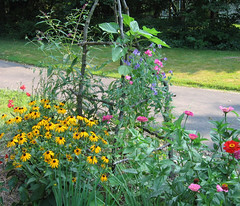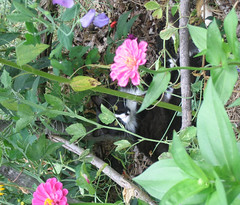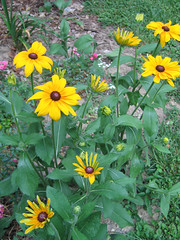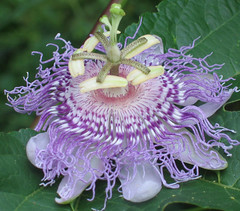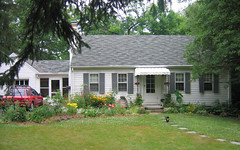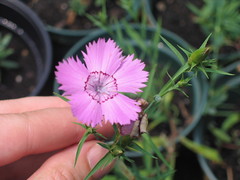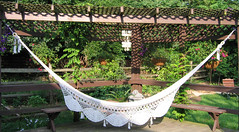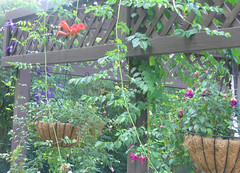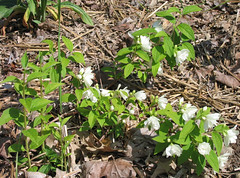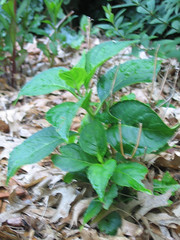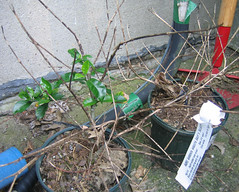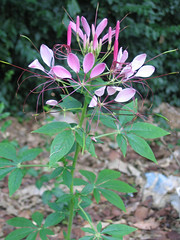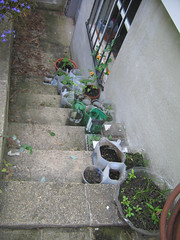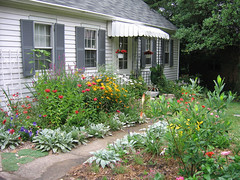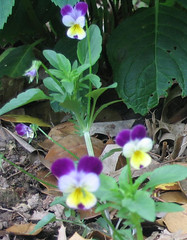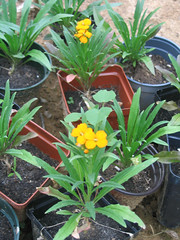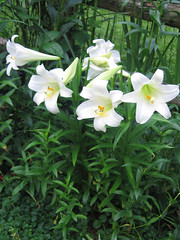I live in College Hill, so when I learned of the local garden tour, I was excited not only to see the gardens, but to get to know the area and my neighbors better. The tour covered a large area - too far to walk, but just right for biking (had I a bicycle). It ranged from a church on Glenview Avenue to a mansion on Belmont to a remodeled ranch house on Larry Avenue.
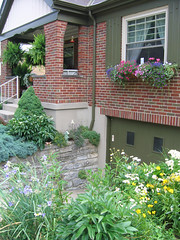
The first stop on the tour, 5734 Nahant Avenue, is described as a cottage garden in the program. The garden was absolutely immaculate. I drooled over the flawlessly edged lawn as well as the
gorgeous baskets adorning the gate into the backyard. The garden is nine years old. According to the home owner, its creation took five years, and the last four have been maintenance. The garden and house are being considered for an article in Better Homes and Gardens magazine. This garden is definitely ready for its close-up.
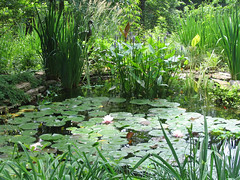
The highlight of the second stop, at 1421 Groesbeck Road, was a large pond, complete with waterfall and bog garden area. The water feature looked absolutely natural in the wooded lot. It is visible from a screened room in the house and, judging by the homeowner’s collection of photos, well enjoyed.
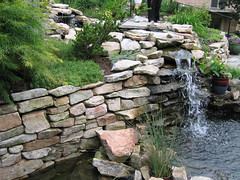
The third stop seemed to be a bit of an odd choice, the belltower garden at the First United Church of Christ. However, I was glad it was included. The pastor’s wife created this garden as a place for members of the congregation to meditate and pray. Upon entering the garden, the first thing the visitors noticed (and oohed and aahed over) was a spectacular
Lucifer crocosmia in boom. (I wondered if I was the only one that appreciated the irony of that particular cultivar in a church garden.) The garden’s centerpiece was a three-tiered pond, connected by rushing waterfalls. Because I visited the garden tour stops out of order, this was my first stop and I enjoyed it so much that I wished it were my last so that I could linger longer.
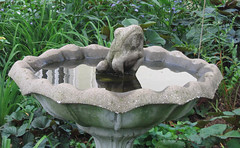
Fifty-six forty Belmont Avenue is one of the big houses I like to ogle as I drive past. Not only is the house big, the lot is enormous. The owners have had their work cut out for them to landscape the space. They’ve wisely planted
a number of shrubs, including the first St. John’s Wort I’ve seen outside of a garden book. The area around the house includes a restfully
shady border and a
fancy fountain.
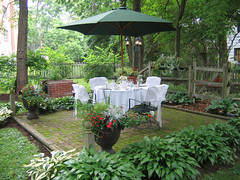
The friendship garden at 1639 Marlowe Avenue was a classy joint, complete with
live violin music, photo albums, and a well-dressed hostess. The garden hosts regular tea parties in its two dining areas. The darling
potting shed was hand built and smelled like cedar. I especially liked the
shade garden, with three windows whimsically hung on the fence.
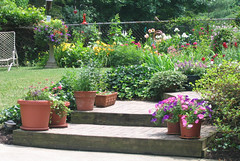
Stop number six, 1570 Larry Avenue, was my favorite garden. It was bright and whimsical. It featured a
cutting garden, a lily garden, and a
pot man. Even the
strip along the driveway was gorgeous. I thought that the choice of a
cobalt blue birdbath in the lily garden was sheer genius.
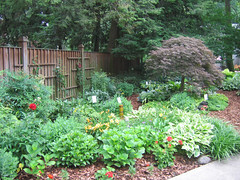
I expected to hate the Asian garden at 1506 Larry Avenue. I imagined it would be all raked sand and contorted evergreens. To my surprise, the mostly shaded garden was lush and beautifully textured. It did feature a few
Japanese maples and a
cast pagoda, but the effect was far from the overly manicured gardens I saw in Japan. I was pleased to see a large, shaded
curbside garden at the end of the driveway. I wish more people would take a chance beyond lawn and hedges in the front yard.
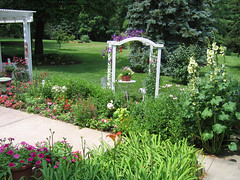
The tour ended at 6563 Edwood Avenue. The garden was my second favorite, because, like 1570 Larry Avenue, it was blowsy and cottagey. I loved the hollyhocks and clematis. The white arbor and
dining set looked fabulous against the backdrop of greenery and flowers. The
mosaic birdbath was the epitome of cottage style.
I had no idea there were so many fabulous gardens tucked into College Hill. I was also impressed with the organization of the tour. There were helpful CHG volunteers and bottles of water at each stop. In each garden, ten plants were labeled with numbers corresponding to Latin and common names found in the tour program. The price, $8.00, was a great deal for the entertainment provided. My goal is to be a tour stop myself, in two years.
See all of my photos from the CHG tour
here.
 I am not referring to the scent of crushed cilantro leaves or bruised chiles, but mignonette, Reseda odorata. I started Josephine Bonaparte’s favorite flower from seed for the promise of an exquisite scent much in vogue during the Victorian era. The blossoms and their famed fragrance make numerous appearances in romantic literature – tucked into bosoms, love letters, and bedclothes. The scent has been described as a deliciously sweet raspberry, but to my nose, it smells of cumin and lard.
I am not referring to the scent of crushed cilantro leaves or bruised chiles, but mignonette, Reseda odorata. I started Josephine Bonaparte’s favorite flower from seed for the promise of an exquisite scent much in vogue during the Victorian era. The blossoms and their famed fragrance make numerous appearances in romantic literature – tucked into bosoms, love letters, and bedclothes. The scent has been described as a deliciously sweet raspberry, but to my nose, it smells of cumin and lard.